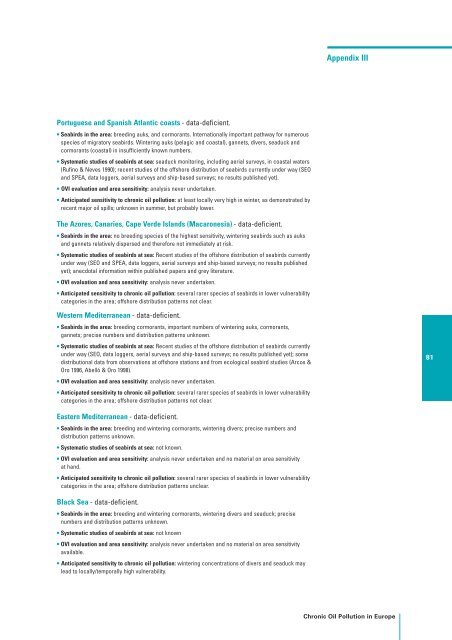Chronic oil pollution in Europe - International Fund for Animal Welfare
Chronic oil pollution in Europe - International Fund for Animal Welfare
Chronic oil pollution in Europe - International Fund for Animal Welfare
You also want an ePaper? Increase the reach of your titles
YUMPU automatically turns print PDFs into web optimized ePapers that Google loves.
Portuguese and Spanish Atlantic coasts - data-deficient.<br />
• Seabirds <strong>in</strong> the area: breed<strong>in</strong>g auks, and cormorants. <strong>International</strong>ly important pathway <strong>for</strong> numerous<br />
species of migratory seabirds. W<strong>in</strong>ter<strong>in</strong>g auks (pelagic and coastal), gannets, divers, seaduck and<br />
cormorants (coastal) <strong>in</strong> <strong>in</strong>sufficiently known numbers.<br />
• Systematic studies of seabirds at sea: seaduck monitor<strong>in</strong>g, <strong>in</strong>clud<strong>in</strong>g aerial surveys, <strong>in</strong> coastal waters<br />
(Ruf<strong>in</strong>o & Neves 1990); recent studies of the offshore distribution of seabirds currently under way (SEO<br />
and SPEA, data loggers, aerial surveys and ship-based surveys; no results published yet).<br />
• OVI evaluation and area sensitivity: analysis never undertaken.<br />
• Anticipated sensitivity to chronic <strong>oil</strong> <strong>pollution</strong>: at least locally very high <strong>in</strong> w<strong>in</strong>ter, as demonstrated by<br />
recent major <strong>oil</strong> spills; unknown <strong>in</strong> summer, but probably lower.<br />
The Azores, Canaries, Cape Verde Islands (Macaronesia) - data-deficient.<br />
• Seabirds <strong>in</strong> the area: no breed<strong>in</strong>g species of the highest sensitivity, w<strong>in</strong>ter<strong>in</strong>g seabirds such as auks<br />
and gannets relatively dispersed and there<strong>for</strong>e not immediately at risk.<br />
• Systematic studies of seabirds at sea: Recent studies of the offshore distribution of seabirds currently<br />
under way (SEO and SPEA, data loggers, aerial surveys and ship-based surveys; no results published<br />
yet); anecdotal <strong>in</strong><strong>for</strong>mation with<strong>in</strong> published papers and grey literature.<br />
• OVI evaluation and area sensitivity: analysis never undertaken.<br />
• Anticipated sensitivity to chronic <strong>oil</strong> <strong>pollution</strong>: several rarer species of seabirds <strong>in</strong> lower vulnerability<br />
categories <strong>in</strong> the area; offshore distribution patterns not clear.<br />
Western Mediterranean - data-deficient.<br />
• Seabirds <strong>in</strong> the area: breed<strong>in</strong>g cormorants, important numbers of w<strong>in</strong>ter<strong>in</strong>g auks, cormorants,<br />
gannets; precise numbers and distribution patterns unknown.<br />
• Systematic studies of seabirds at sea: Recent studies of the offshore distribution of seabirds currently<br />
under way (SEO, data loggers, aerial surveys and ship-based surveys; no results published yet); some<br />
distributional data from observations at offshore stations and from ecological seabird studies (Arcos &<br />
Oro 1996, Abelló & Oro 1998).<br />
• OVI evaluation and area sensitivity: analysis never undertaken.<br />
• Anticipated sensitivity to chronic <strong>oil</strong> <strong>pollution</strong>: several rarer species of seabirds <strong>in</strong> lower vulnerability<br />
categories <strong>in</strong> the area; offshore distribution patterns not clear.<br />
Eastern Mediterranean - data-deficient.<br />
• Seabirds <strong>in</strong> the area: breed<strong>in</strong>g and w<strong>in</strong>ter<strong>in</strong>g cormorants, w<strong>in</strong>ter<strong>in</strong>g divers; precise numbers and<br />
distribution patterns unknown.<br />
• Systematic studies of seabirds at sea: not known.<br />
• OVI evaluation and area sensitivity: analysis never undertaken and no material on area sensitivity<br />
at hand.<br />
• Anticipated sensitivity to chronic <strong>oil</strong> <strong>pollution</strong>: several rarer species of seabirds <strong>in</strong> lower vulnerability<br />
categories <strong>in</strong> the area; offshore distribution patterns unclear.<br />
Black Sea - data-deficient.<br />
• Seabirds <strong>in</strong> the area: breed<strong>in</strong>g and w<strong>in</strong>ter<strong>in</strong>g cormorants, w<strong>in</strong>ter<strong>in</strong>g divers and seaduck; precise<br />
numbers and distribution patterns unknown.<br />
• Systematic studies of seabirds at sea: not known<br />
• OVI evaluation and area sensitivity: analysis never undertaken and no material on area sensitivity<br />
available.<br />
• Anticipated sensitivity to chronic <strong>oil</strong> <strong>pollution</strong>: w<strong>in</strong>ter<strong>in</strong>g concentrations of divers and seaduck may<br />
lead to locally/temporally high vulnerability.<br />
Appendix III<br />
<strong>Chronic</strong> Oil Pollution <strong>in</strong> <strong>Europe</strong><br />
81

















